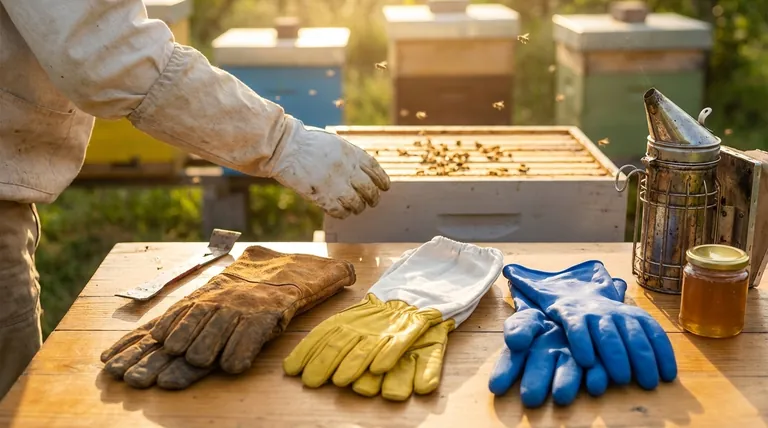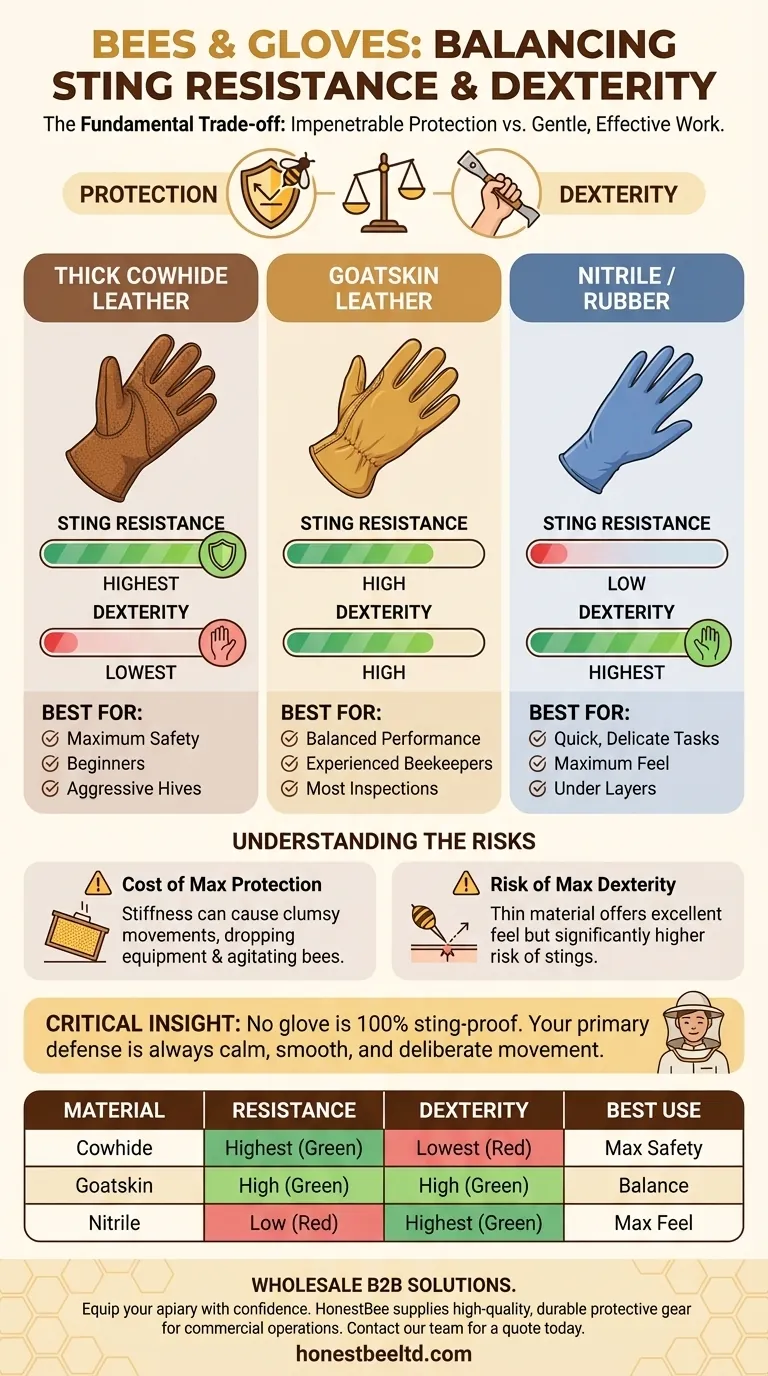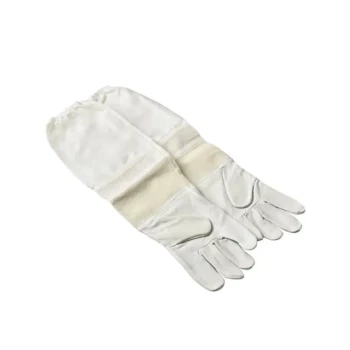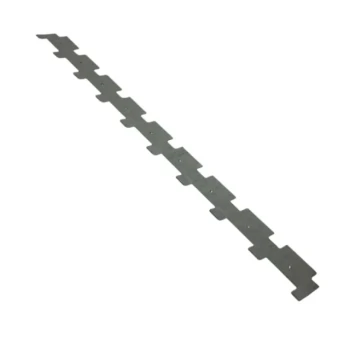When it comes to preventing bee stings, thick leather gloves provide the most reliable resistance. Their density and thickness create a physical barrier that a bee's stinger struggles to penetrate. This makes them the definitive choice for maximum protection.
The search for the perfect beekeeping glove is a fundamental trade-off. You are constantly balancing the need for impenetrable protection against the need for the dexterity required to work gently and effectively within the hive.

How Glove Material Dictates Sting Protection
The effectiveness of any beekeeping glove comes down to one simple principle: puncture resistance. A bee sting is a biological hypodermic needle, and the glove's job is to be too tough for that needle to pierce.
The Gold Standard: Thick Leather
Thick leather, often from cowhide, is the most protective material available. Its dense, interwoven fibers are extremely difficult for a bee's short stinger to push through. This is the material of choice when safety is the absolute top priority.
The Balanced Contender: Goatskin
Goatskin is a thinner, more supple type of leather. While it offers less absolute sting resistance than thick cowhide, it provides significantly more dexterity and "feel." This allows for more delicate movements, making it the most popular choice for experienced beekeepers.
The Disposable Option: Nitrile
Heavy-duty nitrile or rubber gloves offer the highest level of dexterity, second only to bare hands. However, they provide the lowest level of puncture protection. A determined bee can often sting through a single layer of nitrile. Some beekeepers use them for very quick tasks or wear them under looser leather gloves.
Understanding the Trade-offs: Protection vs. Dexterity
Choosing a glove isn't just about finding the thickest material. The wrong glove can create more problems than it solves by making you clumsy and agitated—which in turn agitates the bees.
The Cost of Maximum Protection
The primary drawback of thick leather gloves is their stiffness. This lack of dexterity can make it difficult to handle frames, find the queen, or perform delicate tasks. Clumsy movements can lead to dropping equipment or crushing bees, which releases alarm pheromones and can make a calm hive defensive.
The Risk of Maximum Dexterity
Thin gloves like nitrile give you an excellent feel for your work, but they present a higher risk of stings. While a single sting through a glove is often less severe, it can still happen. This trade-off is often accepted only by highly experienced beekeepers who prioritize speed and have a deep understanding of bee behavior.
No Glove is 100% Sting-Proof
It is critical to understand that no glove can guarantee you will never be stung. Bees can find their way into the cuff, or a stinger may find a weak point in a seam. Your primary defense is always calm, smooth, and deliberate movement.
Making the Right Choice for Your Goal
Your glove choice should align directly with your experience level and the specific task at hand.
- If your primary focus is maximum protection: Choose thick cowhide leather gloves, especially if you are a beginner, work with aggressive colonies, or have a bee allergy.
- If your primary focus is a balance of safety and dexterity: Select high-quality goatskin gloves, which are the versatile industry standard for most day-to-day hive inspections.
- If your primary focus is dexterity for a quick, delicate task: Consider using heavy-duty disposable nitrile gloves, fully understanding they offer minimal sting resistance.
Ultimately, the right glove empowers you to work confidently and calmly, which is your most effective tool in any apiary.
Summary Table:
| Glove Material | Sting Resistance | Dexterity | Best For |
|---|---|---|---|
| Thick Cowhide Leather | Highest | Lowest | Maximum protection, beginners, aggressive hives |
| Goatskin Leather | High | High | Balanced safety and dexterity, experienced beekeepers |
| Nitrile/Rubber | Low | Highest | Quick, delicate tasks requiring maximum feel |
Equip yourself with the right protection to work confidently and calmly. At HONESTBEE, we supply high-quality beekeeping gloves and protective gear to commercial apiaries and equipment distributors. Our wholesale-focused operations ensure you get durable, reliable equipment that balances safety and dexterity for efficient hive management. Contact our team today to discuss your needs and get a quote for your apiary's essential supplies.
Get in Touch for a Wholesale Quote
Visual Guide

Related Products
- Goat Skin Leather Bee Sting Proof Beekeeping Gloves with Canvas Sleeve
- Beekeeping Gloves Goatskin Leather with Long Cotton Sleeve for Beekeepers
- Goatskin Leather Beekeeper Gloves with Vent Long Sleeve for Beekeeping Honey Bee Sting Proof Protection
- Mesh Ventilated 3 Layer Goatskin Beekeepers Gloves for Beekeeping
- Professional Galvanized Hive Strap with Secure Locking Buckle for Beekeeping
People Also Ask
- What types of gloves are commonly used by beekeepers? A Guide to Leather, Goatskin & Nitrile
- How should leather beekeeping gloves be cleaned? A Step-by-Step Guide to Preserve Your Gear
- What are the key features to look for in beekeeping gloves? Find the Perfect Balance of Protection & Dexterity
- What are the steps to clean goat leather beekeeping gloves? A Guide to Extend Gear Life
- What types of gloves are most effective at preventing bee stings? Durable Goatskin & Nitrile Barriers



















